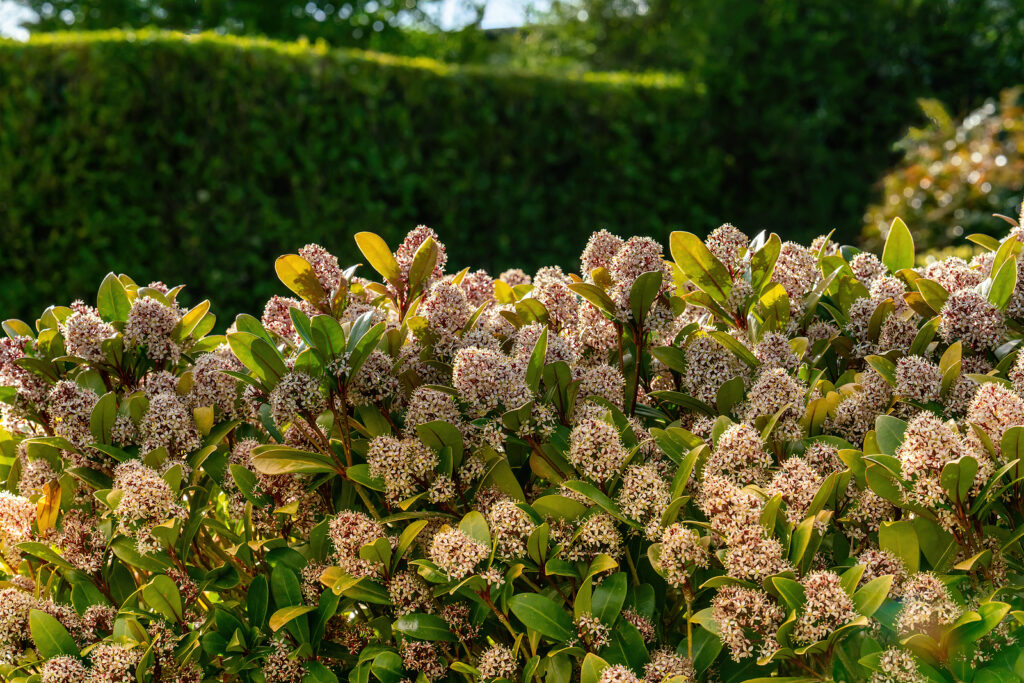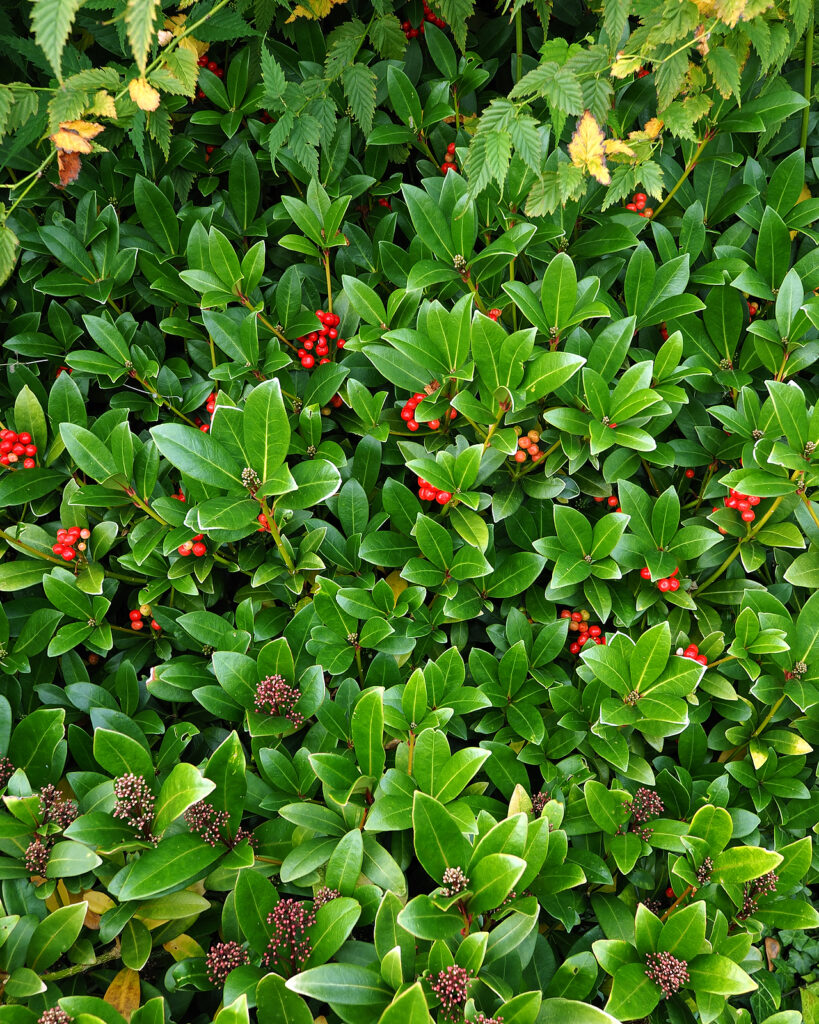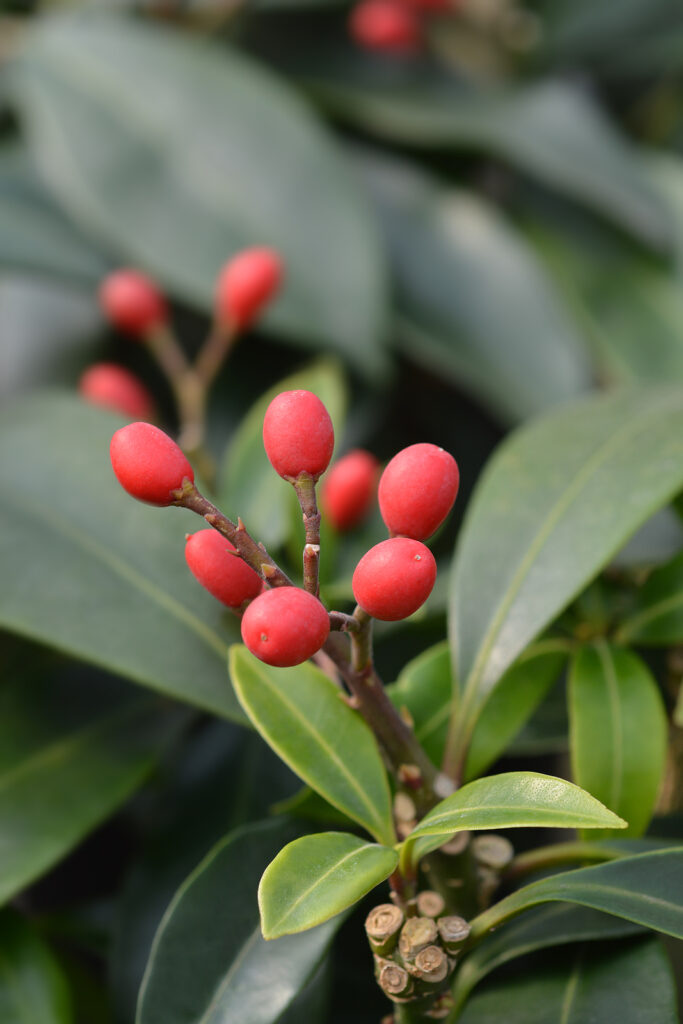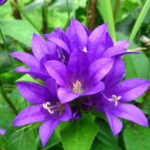Skimmia — Japanese skimmia–are evergreen shrubs and trees grown for their aromatic foliage and often fragrant flower clusters. Some Skimmia species also bear ornamental fruits.
Skimmia tend to be dense rounded shrubs with glossy elliptic leaves. It prefers partial to full shade. In spring, tiny white flowers open from clusters of pinkish buds held above the foliage.
When massed, Skimmia forms a solid foliage cover. It is a good choice to border shaded walkways or as a foundation plant beneath windows. Skimmia blends well with all shade plants.
Skimmia is a genus of four species or monoecious or dioecious evergreen shrubs and trees. It is native to woodlands in the Himalayas, Southeast Asia, China, and Japan.

Get to know Skimmia
- Plant type: Evergreen shrub
- Growing zones and range: Zones 7 to 9
- Hardiness: Hardy to Zone 7
- Height and width: 6 to 20 feet (1.8-6m) tall and wide.
- Foliage: 4 inches (10.2cm) long, glossy, rich green, lance-shaped leaves often form clusters at the ends of branches; shrub may be spreading, rounded, or upright.
- Flowers: Clusters of small, fragrant, white blooms, sometimes flushed with pink or red bloom in spring, and are followed by clusters of holly-like red fruits on female plants in fall and winter.
- Bloom time: Mid- to late spring.
- Uses: Under windows, beside shaded walks, flanking entryways, woodland gardens, along foundations, borders, or in containers.
- Garden companions: ‘Silver Queen’ wintercreeper (Euonymus fortunei ‘Silver Queen’); blend well with all shade plants.
- Common name: Japanese Skimmia
- Botanical name: Skimmia
- Family name: Rutaceae
- Origin: Woodlands from the Himalayas to S.E. Asia to China to Japan
Where to plant Skimmia
- Plant Skimmia in full sun, but can tolerate shade.
- Skimmia does not tolerate heat well.
- Plant Skimmia in deep, rich, moist, acidic soil in a sheltered spot.

When to plant Skimmia
- Set container-grown Skimmia in the garden in spring or autumn.
- Sow seeds in a container in autumn.
Planting and spacing Skimmia
- Space Skimmia 6 to 20 feet (1.8-6m) feet apart depending on the variety.
- Individual plants form dense mounds; when massed they form a soil foliage cover.
- Skimmia has male and female flowers on separate plants, so both are needed to produce fruit.
How to water and feed Skimmia
- Give Skimmia regular water.
- Fertilize Skimia with an all-purpose organic fertilizer in spring.
How to care for Skimmia
- Skimmia does not need pruning.
Skimmia pests and diseases
- Skimmia have few disease problems. However, water mold is a problem in hot regions.
- Skimmia is susceptible to aphids and mites. Mites give the foliage a sunburned look.

Skimmia propagation
- Propagate Skimmia from clean seeds or cuttings taken in fall.
- Root semi-ripe cuttings with bottom heat in mid- and late summer.
Skimmia varieties to grow
- Skimmia S. foremanii, hybrid between S. japonica and S. reevesiana. Resembles S. japonica but is more compact, with broader, heavier, darker green leaves. Plants may be male, female, or self-fertile.
- S. japonica, variable in size. Slow growth to 2-5 feet (.6-1.5m), or taller, 3-6 feet (.9-1.8m) wide. Oval, blunt-ended leaves that are slightly fragrant when bruised, to 3-4 inches (7.6-10.2cm) long and 1 inch (2.5cm) wide, mostly clustered near twig ends. Flowers are borne in 2-3 inches (5.1-7.6cm) clusters; they are larger and more fragrant on male plants. If a male plant is present, female plants produce bright red berries—attractive enough to make planting both sexes with the effort. Red buds open to small white fragrant flowers in 3 inches (7.6cm) upright panicles in early midspring. A form with ivory white berries is available. Male variety ‘Macrophylla’ is a rounded, spreading shrub to 5-6 feet (1.5-1.8m) tall, will large leaves and flowers. Zones 7 and 8.
- S. reevesiana (S. fortunei), dwarf, dense-growing shrub 2 feet (.6m) tall. Self-fertile, with dull crimson fruit. Fragrant flowers. Zones 6 and 7.



